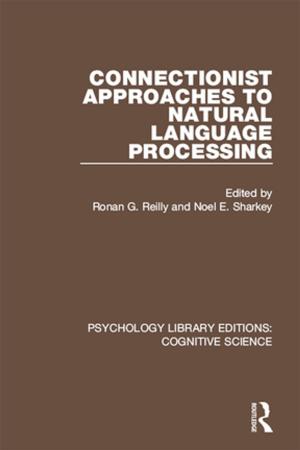Semantic Priming
Perspectives from Memory and Word Recognition
Nonfiction, Health & Well Being, Psychology, Cognitive Psychology| Author: | Timothy P. McNamara | ISBN: | 9781135432546 |
| Publisher: | Taylor and Francis | Publication: | September 8, 2005 |
| Imprint: | Psychology Press | Language: | English |
| Author: | Timothy P. McNamara |
| ISBN: | 9781135432546 |
| Publisher: | Taylor and Francis |
| Publication: | September 8, 2005 |
| Imprint: | Psychology Press |
| Language: | English |
Semantic priming has been a focus of research in the cognitive sciences for more than thirty years and is commonly used as a tool for investigating other aspects of perception and cognition, such as word recognition, language comprehension, and knowledge representations. Semantic Priming: Perspectives from Memory and Word Recognition examines empirical and theoretical advancements in the understanding of semantic priming, providing a succinct, in-depth review of this important phenomenon, framed in terms of models of memory and models of word recognition.
The first section examines models of semantic priming, including spreading activation models, the verification model, compound-cue models, distributed network models, and multistage activation models (e.g. interactive-activation model).
The second section examines issues and findings that have played an especially important role in testing models of priming and includes chapters on the following topics: methodological issues (e.g. counterbalancing of materials, choice of priming baselines); automatic vs. strategic priming; associative vs. “pure” semantic priming; mediated priming; long-term semantic priming; backward priming; unconscious priming; the prime-task effect; list context effects; effects of word frequency, stimulus quality, and stimulus repetition; and the cognitive neuroscience of semantic priming.
The book closes with a summary and a discussion of promising new research directions.
The volume will be of interest to a wide range of researchers and students in the cognitive sciences and neurosciences.
Semantic priming has been a focus of research in the cognitive sciences for more than thirty years and is commonly used as a tool for investigating other aspects of perception and cognition, such as word recognition, language comprehension, and knowledge representations. Semantic Priming: Perspectives from Memory and Word Recognition examines empirical and theoretical advancements in the understanding of semantic priming, providing a succinct, in-depth review of this important phenomenon, framed in terms of models of memory and models of word recognition.
The first section examines models of semantic priming, including spreading activation models, the verification model, compound-cue models, distributed network models, and multistage activation models (e.g. interactive-activation model).
The second section examines issues and findings that have played an especially important role in testing models of priming and includes chapters on the following topics: methodological issues (e.g. counterbalancing of materials, choice of priming baselines); automatic vs. strategic priming; associative vs. “pure” semantic priming; mediated priming; long-term semantic priming; backward priming; unconscious priming; the prime-task effect; list context effects; effects of word frequency, stimulus quality, and stimulus repetition; and the cognitive neuroscience of semantic priming.
The book closes with a summary and a discussion of promising new research directions.
The volume will be of interest to a wide range of researchers and students in the cognitive sciences and neurosciences.















